元音辅音及其差别
- 格式:doc
- 大小:76.00 KB
- 文档页数:18
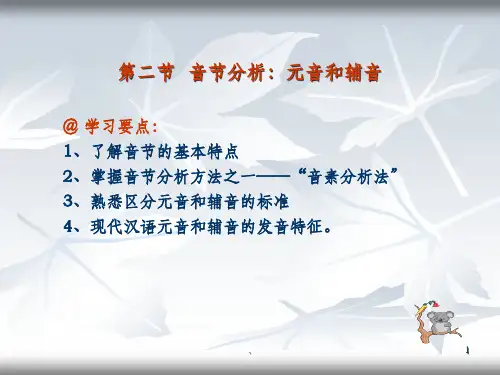
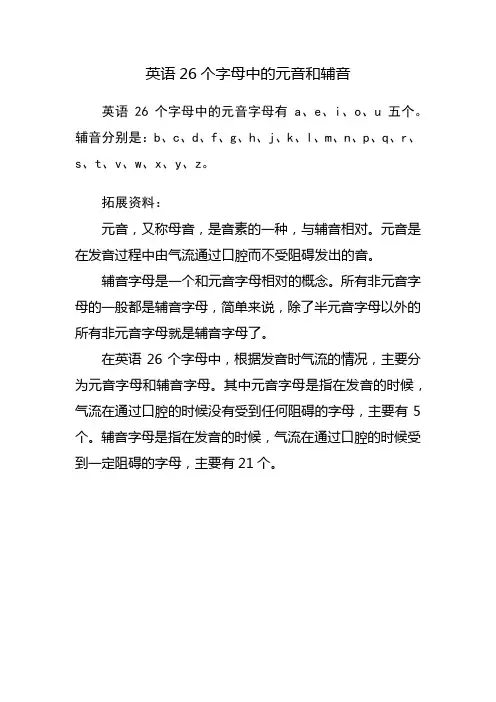
英语26个字母中的元音和辅音
英语26个字母中的元音字母有 a、e、i、o、u 五个。
辅音分别是:b、c、d、f、g、h、j、k、l、m、n、p、q、r、s、t、v、w、x、y、z。
拓展资料:
元音,又称母音,是音素的一种,与辅音相对。
元音是在发音过程中由气流通过口腔而不受阻碍发出的音。
辅音字母是一个和元音字母相对的概念。
所有非元音字母的一般都是辅音字母,简单来说,除了半元音字母以外的所有非元音字母就是辅音字母了。
在英语26个字母中,根据发音时气流的情况,主要分为元音字母和辅音字母。
其中元音字母是指在发音的时候,气流在通过口腔的时候没有受到任何阻碍的字母,主要有5个。
辅音字母是指在发音的时候,气流在通过口腔的时候受到一定阻碍的字母,主要有21个。
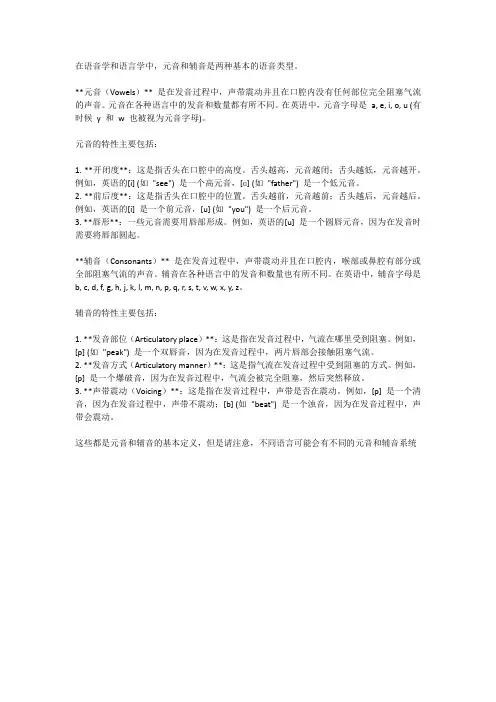
在语音学和语言学中,元音和辅音是两种基本的语音类型。
**元音(Vowels)** 是在发音过程中,声带震动并且在口腔内没有任何部位完全阻塞气流的声音。
元音在各种语言中的发音和数量都有所不同。
在英语中,元音字母是a, e, i, o, u (有时候y 和w 也被视为元音字母)。
元音的特性主要包括:1. **开闭度**:这是指舌头在口腔中的高度。
舌头越高,元音越闭;舌头越低,元音越开。
例如,英语的[i] (如"see") 是一个高元音,[ɑ] (如"father") 是一个低元音。
2. **前后度**:这是指舌头在口腔中的位置。
舌头越前,元音越前;舌头越后,元音越后。
例如,英语的[i] 是一个前元音,[u] (如"you") 是一个后元音。
3. **唇形**:一些元音需要用唇部形成。
例如,英语的[u] 是一个圆唇元音,因为在发音时需要将唇部圆起。
**辅音(Consonants)** 是在发音过程中,声带震动并且在口腔内,喉部或鼻腔有部分或全部阻塞气流的声音。
辅音在各种语言中的发音和数量也有所不同。
在英语中,辅音字母是b, c, d, f, g, h, j, k, l, m, n, p, q, r, s, t, v, w, x, y, z。
辅音的特性主要包括:1. **发音部位(Articulatory place)**:这是指在发音过程中,气流在哪里受到阻塞。
例如,[p] (如"peak") 是一个双唇音,因为在发音过程中,两片唇部会接触阻塞气流。
2. **发音方式(Articulatory manner)**:这是指气流在发音过程中受到阻塞的方式。
例如,[p] 是一个爆破音,因为在发音过程中,气流会被完全阻塞,然后突然释放。
3. **声带震动(Voicing)**:这是指在发音过程中,声带是否在震动。
例如,[p] 是一个清音,因为在发音过程中,声带不震动;[b] (如"beat") 是一个浊音,因为在发音过程中,声带会震动。
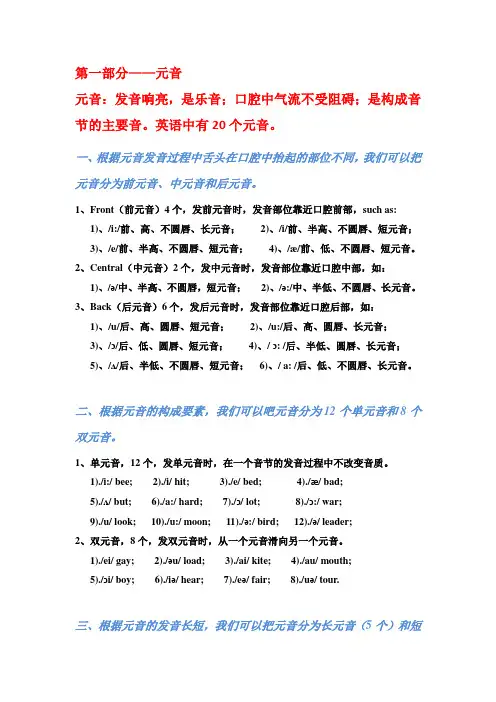
第一部分——元音元音:发音响亮,是乐音;口腔中气流不受阻碍;是构成音节的主要音。
英语中有20个元音。
一、根据元音发音过程中舌头在口腔中抬起的部位不同,我们可以把元音分为前元音、中元音和后元音。
1、Front(前元音)4个,发前元音时,发音部位靠近口腔前部,such as:1)、/i:/前、高、不圆唇、长元音;2)、/i/前、半高、不圆唇、短元音;3)、/e/前、半高、不圆唇、短元音;4)、/æ/前、低、不圆唇、短元音。
2、Central(中元音)2个,发中元音时,发音部位靠近口腔中部,如:1)、/ə/中、半高、不圆唇,短元音;2)、/ə:/中、半低、不圆唇、长元音。
3、Back(后元音)6个,发后元音时,发音部位靠近口腔后部,如:1)、/u/后、高、圆唇、短元音;2)、/u:/后、高、圆唇、长元音;3)、/ɔ/后、低、圆唇、短元音;4)、/ ɔ: /后、半低、圆唇、长元音;5)、/ʌ/后、半低、不圆唇、短元音;6)、/ a: /后、低、不圆唇、长元音。
二、根据元音的构成要素,我们可以吧元音分为12个单元音和8个双元音。
1、单元音,12个,发单元音时,在一个音节的发音过程中不改变音质。
1)./i:/ bee; 2)./i/ hit; 3)./e/ bed; 4)./æ/ bad;5)./ʌ/ but; 6)./a:/ hard; 7)./ɔ/ lot; 8)./ɔ:/ war;9)./u/ look; 10)./u:/ moon; 11)./ə:/ bird; 12)./ə/ leader;2、双元音,8个,发双元音时,从一个元音滑向另一个元音。
1)./ei/ gay; 2)./əu/ load; 3)./ai/ kite; 4)./au/ mouth;5)./ɔi/ boy; 6)./iə/ hear; 7)./eə/ fair; 8)./uə/ tour.三、根据元音的发音长短,我们可以把元音分为长元音(5个)和短元音(7个)。
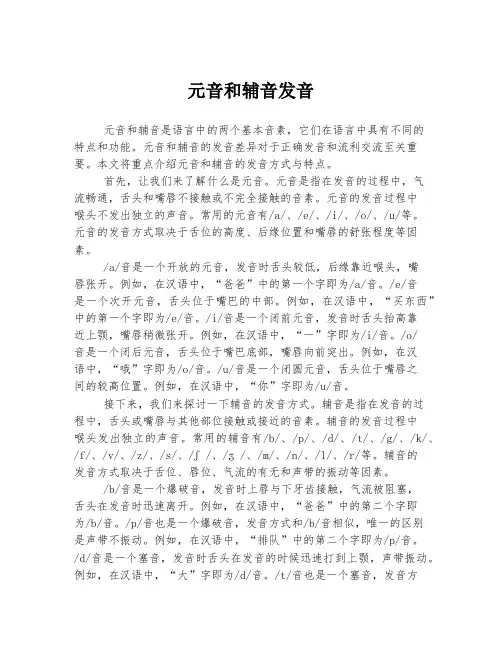
元音和辅音发音元音和辅音是语言中的两个基本音素,它们在语言中具有不同的特点和功能。
元音和辅音的发音差异对于正确发音和流利交流至关重要。
本文将重点介绍元音和辅音的发音方式与特点。
首先,让我们来了解什么是元音。
元音是指在发音的过程中,气流畅通,舌头和嘴唇不接触或不完全接触的音素。
元音的发音过程中喉头不发出独立的声音。
常用的元音有/a/、/e/、/i/、/o/、/u/等。
元音的发音方式取决于舌位的高度、后缘位置和嘴唇的舒张程度等因素。
/a/音是一个开放的元音,发音时舌头较低,后缘靠近喉头,嘴唇张开。
例如,在汉语中,“爸爸”中的第一个字即为/a/音。
/e/音是一个次开元音,舌头位于嘴巴的中部。
例如,在汉语中,“买东西”中的第一个字即为/e/音。
/i/音是一个闭前元音,发音时舌头抬高靠近上颚,嘴唇稍微张开。
例如,在汉语中,“一”字即为/i/音。
/o/音是一个闭后元音,舌头位于嘴巴底部,嘴唇向前突出。
例如,在汉语中,“哦”字即为/o/音。
/u/音是一个闭圆元音,舌头位于嘴唇之间的较高位置。
例如,在汉语中,“你”字即为/u/音。
接下来,我们来探讨一下辅音的发音方式。
辅音是指在发音的过程中,舌头或嘴唇与其他部位接触或接近的音素。
辅音的发音过程中喉头发出独立的声音。
常用的辅音有/b/、/p/、/d/、/t/、/g/、/k/、/f/、/v/、/z/、/s/、/ʃ/、/ʒ/、/m/、/n/、/l/、/r/等。
辅音的发音方式取决于舌位、唇位、气流的有无和声带的振动等因素。
/b/音是一个爆破音,发音时上唇与下牙齿接触,气流被阻塞,舌头在发音时迅速离开。
例如,在汉语中,“爸爸”中的第二个字即为/b/音。
/p/音也是一个爆破音,发音方式和/b/音相似,唯一的区别是声带不振动。
例如,在汉语中,“排队”中的第二个字即为/p/音。
/d/音是一个塞音,发音时舌头在发音的时候迅速打到上颚,声带振动。
例如,在汉语中,“大”字即为/d/音。
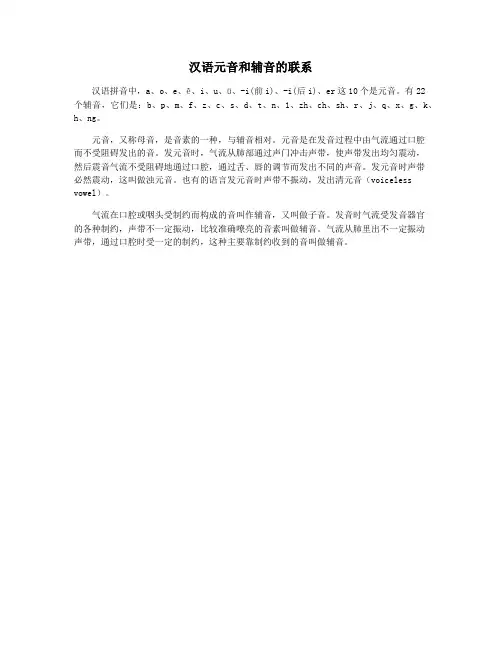
汉语元音和辅音的联系
汉语拼音中,a、o、e、ê、i、u、ü、-i(前i)、-i(后i)、er这10个是元音。
有22
个辅音,它们是:b、p、m、f、z、c、s、d、t、n、1、zh、ch、sh、r、j、q、x、g、k、h、ng。
元音,又称母音,是音素的一种,与辅音相对。
元音是在发音过程中由气流通过口腔
而不受阻碍发出的音。
发元音时,气流从肺部通过声门冲击声带,使声带发出均匀震动,
然后震音气流不受阻碍地通过口腔,通过舌、唇的调节而发出不同的声音。
发元音时声带
必然震动,这叫做浊元音。
也有的语言发元音时声带不振动,发出清元音(voiceless vowel)。
气流在口腔或咽头受制约而构成的音叫作辅音,又叫做子音。
发音时气流受发音器官
的各种制约,声带不一定振动,比较准确嘹亮的音素叫做辅音。
气流从肺里出不一定振动
声带,通过口腔时受一定的制约,这种主要靠制约收到的音叫做辅音。
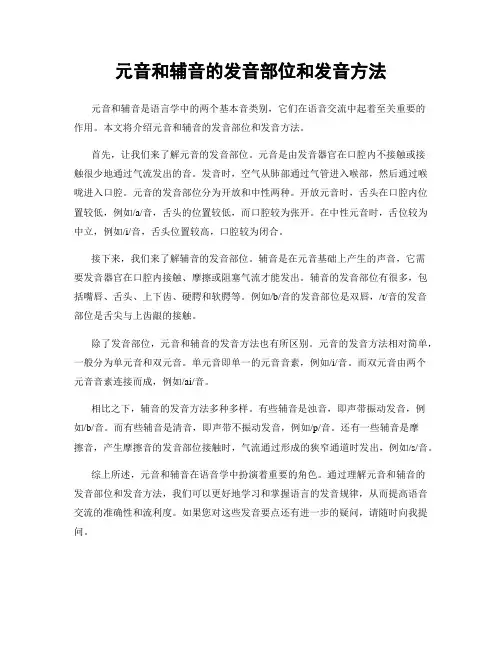
元音和辅音的发音部位和发音方法元音和辅音是语言学中的两个基本音类别,它们在语音交流中起着至关重要的作用。
本文将介绍元音和辅音的发音部位和发音方法。
首先,让我们来了解元音的发音部位。
元音是由发音器官在口腔内不接触或接触很少地通过气流发出的音。
发音时,空气从肺部通过气管进入喉部,然后通过喉咙进入口腔。
元音的发音部位分为开放和中性两种。
开放元音时,舌头在口腔内位置较低,例如/a/音,舌头的位置较低,而口腔较为张开。
在中性元音时,舌位较为中立,例如/i/音,舌头位置较高,口腔较为闭合。
接下来,我们来了解辅音的发音部位。
辅音是在元音基础上产生的声音,它需要发音器官在口腔内接触、摩擦或阻塞气流才能发出。
辅音的发音部位有很多,包括嘴唇、舌头、上下齿、硬腭和软腭等。
例如/b/音的发音部位是双唇,/t/音的发音部位是舌尖与上齿龈的接触。
除了发音部位,元音和辅音的发音方法也有所区别。
元音的发音方法相对简单,一般分为单元音和双元音。
单元音即单一的元音音素,例如/i/音。
而双元音由两个元音音素连接而成,例如/ai/音。
相比之下,辅音的发音方法多种多样。
有些辅音是浊音,即声带振动发音,例如/b/音。
而有些辅音是清音,即声带不振动发音,例如/p/音。
还有一些辅音是摩擦音,产生摩擦音的发音部位接触时,气流通过形成的狭窄通道时发出,例如/s/音。
综上所述,元音和辅音在语音学中扮演着重要的角色。
通过理解元音和辅音的发音部位和发音方法,我们可以更好地学习和掌握语言的发音规律,从而提高语音交流的准确性和流利度。
如果您对这些发音要点还有进一步的疑问,请随时向我提问。
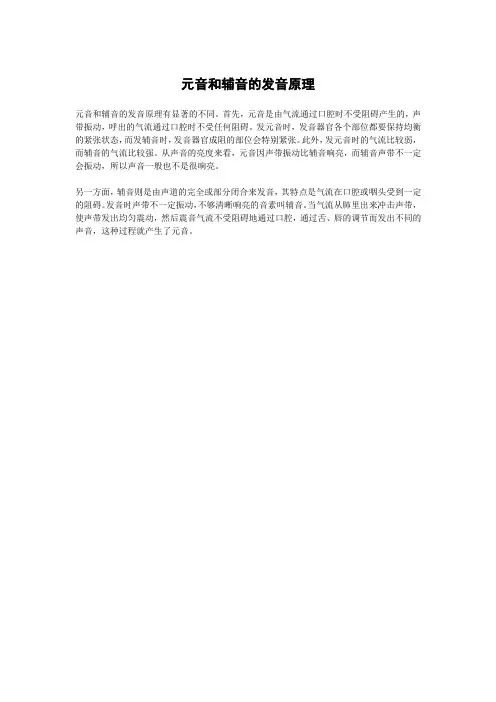
元音和辅音的发音原理
元音和辅音的发音原理有显著的不同。
首先,元音是由气流通过口腔时不受阻碍产生的,声带振动,呼出的气流通过口腔时不受任何阻碍。
发元音时,发音器官各个部位都要保持均衡的紧张状态,而发辅音时,发音器官成阻的部位会特别紧张。
此外,发元音时的气流比较弱,而辅音的气流比较强。
从声音的亮度来看,元音因声带振动比辅音响亮,而辅音声带不一定会振动,所以声音一般也不是很响亮。
另一方面,辅音则是由声道的完全或部分闭合来发音,其特点是气流在口腔或咽头受到一定的阻碍。
发音时声带不一定振动,不够清晰响亮的音素叫辅音。
当气流从肺里出来冲击声带,使声带发出均匀震动,然后震音气流不受阻碍地通过口腔,通过舌、唇的调节而发出不同的声音,这种过程就产生了元音。
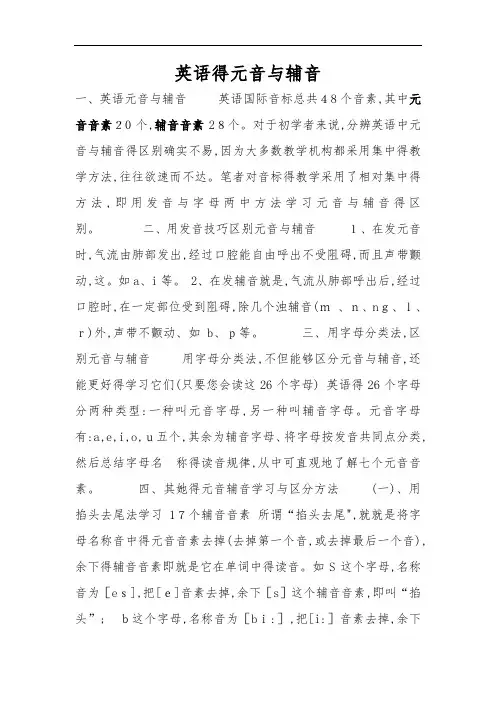
英语得元音与辅音一、英语元音与辅音英语国际音标总共48个音素,其中元音音素20个,辅音音素28个。
对于初学者来说,分辨英语中元音与辅音得区别确实不易,因为大多数教学机构都采用集中得教学方法,往往欲速而不达。
笔者对音标得教学采用了相对集中得方法,即用发音与字母两中方法学习元音与辅音得区别。
二、用发音技巧区别元音与辅音1、在发元音时,气流由肺部发出,经过口腔能自由呼出不受阻碍,而且声带颤动,这。
如a、i等。
2、在发辅音就是,气流从肺部呼出后,经过口腔时,在一定部位受到阻碍,除几个浊辅音(m、n、ng、l、r)外,声带不颤动、如b、p等。
三、用字母分类法,区别元音与辅音用字母分类法,不但能够区分元音与辅音,还能更好得学习它们(只要您会读这26个字母) 英语得26个字母分两种类型:一种叫元音字母,另一种叫辅音字母。
元音字母有:a,e,i,o,u五个,其余为辅音字母、将字母按发音共同点分类,然后总结字母名称得读音规律,从中可直观地了解七个元音音素。
四、其她得元音辅音学习与区分方法 (一)、用掐头去尾法学习17个辅音音素所谓“掐头去尾",就就是将字母名称音中得元音音素去掉(去掉第一个音,或去掉最后一个音),余下得辅音音素即就是它在单词中得读音。
如S这个字母,名称音为[es],把[e]音素去掉,余下[s]这个辅音音素,即叫“掐头”; b这个字母,名称音为[bi:],把[i:]音素去掉,余下[b]这个辅音音素,即叫“去尾”。
在26个字母中有15个辅音字母与一个元音字母及一个半元音字母可用“掐头去尾法”得到它们得辅音音素。
1、用“掐头法”学习六个辅音音素 F [ef] [e][f]L[el][e][1] M[em][e][m]N[en][e][n] S[es] [e][s] X[eks] [e][k][s]2、用“去尾法”学习九个辅音音素 B[bi:] [b][i:]C[si:] [s][i:] D[di:][d][i:]J[d3ei] [d3][ei]K[kei][k][ei]P[pi:] [p][i:]T[ti:] [t][i:] V[vi:] [v][i:]Z[zed] [z][e][d]英语共有48个音素,其中元音20个、元音分为单元音与双元音、辅音分为清辅音与浊辅音!不过按老师教得元音字母五个a e io u辅音字母二十一个bc d f g h j k lmn p q r s t vw xyz元音字母在单词中不发音得规则,一般有4条:一、-e在词尾,一般不发音,如:life[laif] (生命)face [feis](脸)home [hεum] (家)二、一些来自法语得词得词尾—que或gue,其中—ue不发音,如:tongue [t∧η] (舌头)dialogue ['daiεl)g](对话)technique[tek'ni:k] (技巧)三、在轻读音节,有些词得词尾中得元音不发音,如:1) -al capital [’k?pitl] (首都)2) —engarden ['ga:dn] (花园)3) —ed burned [bε:nd] (燃烧)4) —el vessel ['vesl] (船)5) —in basin[’beisn] (脸盆)6) -il evil ['i:vl] (邪恶)7) —on button [’b∧tn] (钮扣)但在[k]、[g]与[nd]音之后得元音,仍然发音,如:bacon ['beikεn] (熏猪肉)waggon[’w?gεn] (运货马车)london [’l∧ndεn] (伦敦)四、在轻读音节中,在词中间得-en-,-er—,其中得元音不发音,如:-en- absent [’?bsnt] (缺席)recent ['ri:snt] (最近)every[’evri] (每个)several [’sevrεl](几个)辅音字母在单词中不发音得规则,一般有下列14条:一、字母b在字母t之前,如:debt [det](欠债)二、字母b在字母m之后,如:comb [kεum] (梳子)三、字母c在字母s之后,如:muscle [’m∧sl] (肌肉)四、字母d在词尾—dge中,如:bridge [brid3] (桥)五、字母g在字母n之前,如:sign [sain] (标记)六、字母gh在t之前,如:fight [fait] (打)七、字母h在r之后,如:rhythem ['riem] (节奏)八、字母h在词首ex—之后,如:exhibition[eksi'bi∫n] (展览会) 九、字母h在词首gh中,如:ghost [gεust](鬼)十、字母k在字母n之前,如:knee[ni:] (膝)十一、字母l在-alf,-alk,-alm,—ould中,如:talk[t):k] (谈话)half [ha:f] (一半)calm [ka:m] (平静)could [kud] (能)十二、字母n在词尾-mn中,如:autumn [’):tεm] (秋天)十三、字母t在词尾-sten,—stlet与-ften中,如:listen [' lisn] (听)castle[’ka:sl] (城堡)、soften ['s)fn] (软化)十四、字母w在字母r之前,如:wrong [r]η] (错)。

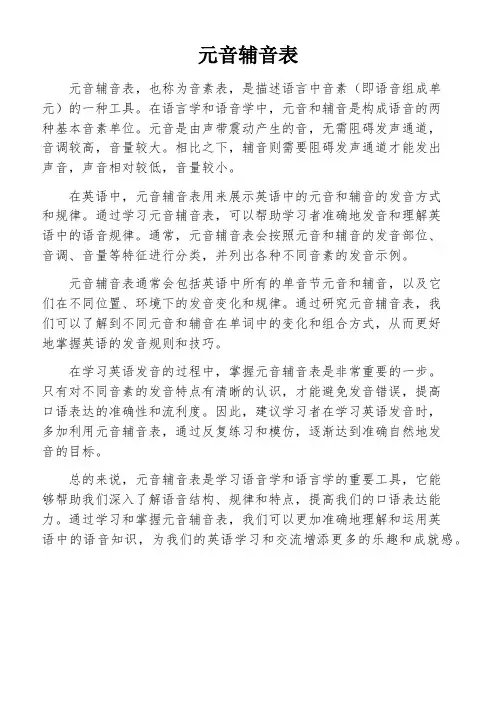
元音辅音表
元音辅音表,也称为音素表,是描述语言中音素(即语音组成单元)的一种工具。
在语言学和语音学中,元音和辅音是构成语音的两
种基本音素单位。
元音是由声带震动产生的音,无需阻碍发声通道,
音调较高,音量较大。
相比之下,辅音则需要阻碍发声通道才能发出
声音,声音相对较低,音量较小。
在英语中,元音辅音表用来展示英语中的元音和辅音的发音方式
和规律。
通过学习元音辅音表,可以帮助学习者准确地发音和理解英
语中的语音规律。
通常,元音辅音表会按照元音和辅音的发音部位、
音调、音量等特征进行分类,并列出各种不同音素的发音示例。
元音辅音表通常会包括英语中所有的单音节元音和辅音,以及它
们在不同位置、环境下的发音变化和规律。
通过研究元音辅音表,我
们可以了解到不同元音和辅音在单词中的变化和组合方式,从而更好
地掌握英语的发音规则和技巧。
在学习英语发音的过程中,掌握元音辅音表是非常重要的一步。
只有对不同音素的发音特点有清晰的认识,才能避免发音错误,提高
口语表达的准确性和流利度。
因此,建议学习者在学习英语发音时,
多加利用元音辅音表,通过反复练习和模仿,逐渐达到准确自然地发
音的目标。
总的来说,元音辅音表是学习语音学和语言学的重要工具,它能
够帮助我们深入了解语音结构、规律和特点,提高我们的口语表达能力。
通过学习和掌握元音辅音表,我们可以更加准确地理解和运用英
语中的语音知识,为我们的英语学习和交流增添更多的乐趣和成就感。
元音辅音及其差别元音12个单元音长元音[i:][E:][C:][u:][B:]短元音[E][C][Q][e][A]8个双元音[ai][ei][Ci][iE][ZE][uE][Eu][au]辅音10对清辅音[p][t][k][f][s][W][F][tF][tr][ts]浊辅音[d][g][v][z][T][V][dV][dr][dz]3个鼻音[m] [n] [N]3个似拼音[h] [r] [l]2个半元音[w] [j]二,其次我们看理论定义:元音(vowel)发音时从肺部呼出的气流通过起共鸣器作用的口腔,阻力极小并无摩擦声音的语音。
半元音的发音方法与元音相同。
但常被视为辅音;yawn(打呵欠)中的y音,walk(步行)中的w音是半元音。
元音,又称母音,是音素的一种,与辅音相对。
元音是在发音过程中由气流通过口腔而不受阻碍发出的音。
发元音时,气流从肺部通过声门冲击声带,使声带发出均匀震动,然后震音气流不受阻碍的通过口腔、鼻腔,通过舌、唇的调节而发出不同的声音。
发元音时声带必然震动,这叫做浊音。
也有的语言发元音时声带不振动,发出清元音(voiceless vowel)。
英语中音素分为元音音素和辅音音素两大类。
其中元音音素20个,辅音音素24个。
辅音:不论声带振动与否,发声时呼出的气流通过口腔或鼻腔时受到一定阻碍,这样的语音称为辅音。
辅音发音不响亮,口腔中气流受到阻碍,不是构成音节的主要音。
英语中有24个辅音。
(有的书将[ts]、[dz]、[tr]、[dr] 也归为辅音,即有28个辅音,共48个音素。
)辅音有清辅音和浊辅音之分,同样的发音位置,如果声带震动就是浊辅音,如果声带不震动就是清辅音了如:。
[p] [t] [k]三个音发音时声带不振动,叫做清辅音,[b] [d] [g] 三个音发音时声带振动,叫做浊辅音。
[f] [s] [h] [ W ] [ F ]五个音为清辅音,[v] [z] [r] [w] [j] [T ] [ V ]七个音为浊辅音。
元音字母是26个字母中的a e i o u 其他的是辅音字母注意:元音字母和元音不同辅音字母和辅音不同另外清浊辅音的区别也仅仅与声带振动有关。
发清辅音时声带不会振动,发浊辅音时声带会振动。
A Brief Look at the History of EnglishThe history of English is conventionally, if perhaps too neatly, divided into three periods usually called Old English (or Anglo-Saxon), Middle English, and Modern English. The earliest period begins with the migration of certain Germanic tribes from the continent to Britain in the fifth century A. D., though no records of their language survive from before the seventh century, and it continues until the end of the eleventh century or a bit later. By that time Latin, Old Norse (the language of the Viking invaders), and especially the Anglo-Norman French of the dominant class after the Norman Conquest in 1066 had begun to have a substantial impact on the lexicon, and the well-developed inflectional system that typifies the grammar of Old English had begun to break down. The following brief sample of Old English prose illustrates several of the significant ways in which change has so transformed English that we must look carefully to find points of resemblance between the language of the tenth century and our own. It is taken from Aelfric's "Homily on St. Gregory the Great" and concerns the famous story of how thatpope came to send missionaries to convert the Anglo-Saxons to Christianity after seeing Anglo-Saxon boys for sale as slaves inRome:Eft he axode, hu ðære ðeode nama wære þe hi of comon. Him wæs geandwyrd, þæt hi Angle genemnode wæron. Þa cwæð he, "Rihtlice hi sind Angle gehatene, for ðan ðe hi engla wlite habbað, and swilcum gedafenað þæt hi on heofonum engla geferan beon."A few of these words will be recognized as identical in spelling with their modern equivalents -- he, of, him, for, and, on -- and the resemblance of a few others to familiar words may be guessed -- nama to name, comon to come, wære to were, wæs to was -- but only those who have made a special study of Old English will be able to read the passage with understanding. The sense of it is as follows: "Again he [St. Gregory] asked what might be the name of the people from which they came. It was answered to him that they were named Angles. Then he said, 'Rightly are they called Angles because they have the beauty of angels, and it is fitting that such as they should be angels' companions in heaven.' " Some of the words in the original have survived in altered form, including axode (asked), hu (how), rihtlice (rightly), engla (angels), habbað (have), swilcum (such), heofonum (heaven), and beon (be). Others, however, have vanished from our lexicon, mostly without a trace, including several that were quite common words in Old English: eft "again," ðeode "people, nation," cwæð "said, spoke," gehatene "called, named," wlite "appearance, beauty," and geferan "companions." Recognition of some words is naturally hindered by the presence of two special characters, þ, called "thorn," and ð, called "edh," which served in Old English to represent the sounds now spelled with th.Other points worth noting include the fact that the pronoun system did not yet, in the late tenth century, include the third person plural forms beginning with th-: hi appears where we would use they. Several aspects of word order will also strike the reader as oddly unlike ours. Subject and verb are inverted after an adverb -- þa cwæð he "Then said he" -- a phenomenon not unknown in Modern English but now restricted to a few adverbs such as never and requiring the presence of an auxiliary verb like do or have. In subordinate clauses the main verb must be last, and so an object or a preposition may precede it in a way no longer natural: þe hi of comon "which they from came," for ðan ðe hi engla wlite habbað "because they angels' beauty have."Perhaps the most distinctive difference between Old and Modern English reflected in Aelfric's sentences is the elaborate system of inflections, of which we now have only remnants. Nouns, adjectives, and even the definite article are inflected for gender, case, and number: ðære ðeode "(of) the people" is feminine, genitive, and singular, Angle "Angles" is masculine, accusative, and plural, and swilcum "such" is masculine, dative, and plural. The system of inflections for verbs was also more elaborate than ours: for example, habbað "have" ends with the -að suffix characteristic of plural present indicative verbs. In addition, there were two imperative forms, four subjunctive forms (two for the present tense and two for the preterit, or past, tense), and several others which we no longer have. Even where Modern English retains a particular category of inflection, the form has often changed. Old English present participles ended in -ende not -ing, and past participles bore a prefix ge- (as geandwyrd "answered" above).The period of Middle English extends roughly from the twelfth century through the fifteenth. The influence of French (and Latin, often by way of French) upon the lexicon continued throughout this period, the loss of some inflections and the reduction of others (often to a final unstressed vowel spelled -e) accelerated, and many changes took place within the phonological and grammatical systems of the language. A typical prose passage, especially one from the later part of the period, will not have such a foreign look to us as Aelfric's prose has; but it will not be mistaken for contemporary writing either. The following brief passage is drawn from a work of the late fourteenth century called Mandeville's Travels. It is fiction in the guise of travel literature, and, though it purports to be from the pen of an English knight, it was originally written in French and later translated into Latin and English. In this extract Mandeville describes the land of Bactria, apparently not an altogether inviting place, as it is inhabited by "full yuele [evil] folk and full cruell."In þat lond ben trees þat beren wolle, as þogh it were of scheep; whereof men maken clothes, an d all þing þat may ben made of wolle. In þat contree ben many ipotaynes, þat dwellen som tyme in the water, and somtyme on the lond: and þei ben half man and half hors, as I haue seyd before; and þei eten men, whan þei may take hem. And þere ben ryueres an d watres þat ben fulle byttere, þree sithes more þan is the water of the see. In þat contré ben many griffounes, more plentee þan in ony other contree. Sum men seyn þat þei han the body vpward as an egle, and benethe as a lyoun: and treuly þei seyn soth þat þei ben of þat schapp. But o griffoun hath the body more gret, and is more strong,þanne eight lyouns, of suche lyouns as ben o this half; and more gret and strongere þan an hundred egles, suche as we han amonges vs. For o griffoun þere wil bere fleynge to his nest a gret hors, 3if he may fynde him at the poynt, or two oxen 3oked togidere, as þei gon at the plowgh.The spelling is often peculiar by modern standards and even inconsistent within these few sentences (contré and contree, o [griffoun] and a [gret hors], þanne and þan, for example). Moreover, in the original text, there is in addition to thorn another old character 3, called "yogh," to make difficulty. It can represent several sounds but here may be thought of as equivalent to y. Even the older spellings (including those where u stands for v or vice versa) are recognizable, however, and there are only a few words like ipotaynes "hippopotamuses" and sithes "times" that have dropped out of the language altogether. We may notice a few words and phrases that have meanings no longer common such as byttere "salty," o this half "on this side of the world," and at the poynt "to hand," and the effect of the centuries-long dominance of French on the vocabulary is evident in many familiar words which could not have occurred in Aelfric's writing even if his subject had allowed them, words like contree, ryueres, plentee, egle, and lyoun.In general word order is now very close to that of our time, though we notice constructions like hath the body more gret and three sithes more þan is the water of the see. We also notice that present tense verbs still receive a plural inflection as in beren, dwellen, han, and ben and that while nominative þei has replaced Aelfric's hi in the third person plural, the form for objects is still hem. All the same, the number of inflections for nouns, adjectives, and verbs has been greatly reduced, and in most respects Mandeville is closer to Modern than to Old English.The period of Modern English extends from the sixteenth century to our own day. The early part of this period saw the completion of a revolution in the phonology of English that had begun in late Middle English and that effectively redistributed the occurrence of the vowel phonemes to something approximating their present pattern. (Mandeville's English would have sounded even less familiar to us than it looks.) Other important early developments include the stabilizing effect on spelling of the printing press and the beginning of the direct influence of Latin and, to a lesser extent, Greek on the lexicon. Later, as English came into contact with other cultures around the world and distinctive dialects of English developed in the many areas which Britain had colonized, numerous other languages made small but interesting contributions to our word-stock.英语写作常用修辞方法发布时间:2010-07-15 浏览次数:英语中的修辞与汉语的修辞相比,分类细,种类多.下面将英语的修辞简单介绍如下:1.Simile 明喻明喻是将具有共性的不同事物作对比.这种共性存在于人们的心里,而不是事物的自然属性.标志词常用like, as, seem, as if, as though, similar to, such as 等.例如:1>.He was like a cock who thought the sun had risen to hear him crow.2>.I wandered lonely as c cloud.3>.Einstein only had a blanket on, as if he had just walked out of a fairy tale.2.Metaphor 隐喻,暗喻隐喻是简缩了的明喻,是将某一事物的名称用于另一事物,通过比较形成.例如:1>.Hope is a good breakfast, but it is a bad supper.2>.Some books are to be tasted, others swallowed, and some few to be chewed and digested.3.Metonymy 借喻,转喻借喻不直接说出所要说的事物,而使用另一个与之相关的事物名称.I.以容器代替内容,例如:1>.The kettle boils. 水开了.2>.The room sat silent. 全屋人安静地坐着.II.以资料.工具代替事物的名称,例如:Lend me your ears, please. 请听我说.III.以作者代替作品,例如:a complete Shakespeare 莎士比亚全集VI.以具体事物代替抽象概念,例如:I had the muscle, and they made money out of it.我有力气,他们就用我的力气赚钱.4.Synecdoche 提喻提喻用部分代替全体,或用全体代替部分,或特殊代替一般.例如:1>.There are about 100 hands working in his factory.他的厂里约有100名工人.2>.He is the Newton of this century.他是本世纪的牛顿.3>.The fox goes very well with your cap.这狐皮围脖与你的帽子很相配.5.Synaesthesia 通感,联觉,移觉这种修辞法是以视.听.触.嗅.味等感觉直接描写事物.例如:1>.The birds sat upon a tree and poured forth their lily like voice.鸟儿落在树上,倾泻出百合花似的声音.2>.Taste the music of Mozart.品尝Mozart的音乐.6.Personification 拟人拟人是把生命赋予无生命的事物.例如:1>.The night gently lays her hand at our fevered heads.2>.I was very happy and could hear the birds singing in the woods.7.Hyperbole 夸张夸张是以言过其实的说法表达强调的目的.它可以加强语势,增加表达效果..例如:1>.I beg a thousand pardons.2>.Love you. You are the whole world to me, and the moon and the stars.3>.When she heard the bad news, a river of tears poured out.8.Parallelism 排比, 平行这种修辞法是把两个或两个以上的结构大体相同或相似,意思相关,语气一致的短语.句子排列成串,形成一个整体.例如:1>.No one can be perfectly free till all are free; no one can be perfectly moral till all are moral; no one can be perfectly happy till all are happy.2>.In the days when all these things are to be answered for,I summon you and yours, to the last of your bad race, to answer for them. In the days when all these things are to be answered for, I summon your brother, the worst of your bad race, to answer for them separately.9.Euphemism 委婉,婉辞法婉辞法指用委婉,文雅的方法表达粗恶,避讳的话.例如:1>.He is out visiting the necessary.他出去方便一下.2>.His relation with his wife has not been fortunate.他与妻子关系不融洽.3>.Deng Xiaoping passed away in 1997.10.Allegory 讽喻,比方这是一种源于希腊文的修辞法,意为"换个方式的说法".它是一种形象的描述,具有双重性,表层含义与真正意味的是两回事.例如:1>.Make the hay while the sun shines.2>.It's time to turn plough into sword.11.Irony 反语反语指用相反意义的词来表达意思的作文方式.如在指责过失.错误时,用赞同过失的说法,而在表扬时,则近乎责难的说法.例如:1>.It would be a fine thing indeed not knowing what time it was in the morning.2>"Of course, you only carry large notes, no small change on you. "the waiter said to the beggar.12.Pun 双关双关就是用一个词在句子中的双重含义,借题发挥.作出多种解释,旁敲侧击,从而达到意想不到的幽默.滑稽效果.它主要以相似的词形.词意和谐音的方式出现.例如:1>.She is too low for a high praise, too brown for a fair praise and too little for a great praise.2>.An ambassador is an honest man who lies abroad for the good of his country.3>.If we don't hang together, we shall hang separately.13.Parody 仿拟这是一种模仿名言.警句.谚语,改动其中部分词语,从而使其产生新意的修辞.例如:1>.Rome was not built in a day, nor in a year.2>.A friend in need is a friend to be avoided.3>.If you give a girl an inch nowadays she will make address of it.14.Rhetorical question 修辞疑问它与疑问句的不同在于它并不以得到答复为目的,而是以疑问为手段,取得修辞上的效果,其特点是:肯定问句表示强烈否定,而否定问句表示强烈的肯定.它的答案往往是不言而喻的.例如:1>.How was it possible to walk for an hour through the woods and see nothing worth of note?2>.Shall we allow those untruths to go unanswered?15.Antithesis 对照,对比,对偶这种修辞指将意义完全相反的语句排在一起对比的一种修辞方法.例如:1>.Not that I loved Caeser less but that I loved Romemore.2>.You are staying; I am going.3>.Give me liberty, or give me death.16.Paradox 隽语这是一种貌似矛盾,但包含一定哲理的意味深长的说法,是一种矛盾修辞法..例如:1>.More haste, less speed.2>.The child is the father to the man.17.Oxymoron 反意法,逆喻这也是一种矛盾修辞法,用两种不相调和的特征形容一个事物,以不协调的搭配使读者领悟句中微妙的含义.例如:1>.No light, but rather darkness visible.2>.The state of this house is cheerless welcome.18.Climax 渐进法,层进法这种修辞是将一系列词语按照意念的大小.轻重.深浅.高低等逐层渐进,最后达到顶点.可以增强语势,逐渐加深读者印象.例如:1>.I am sorry, I am so sorry, I am so extremely sorry.2>.Eye had not seen nor ear heard, and nothing had touchedhis heart of stone.19.Anticlimax 渐降法与climax相反的一种修辞法,将一系列词语由大到小,由强到弱地排列.例如:1>.On his breast he wears his decorations, at his side asword, on his feet a pair of boots.2>.The duties of a soldier are to protect his country and peelpotatoes.The Bronte Sisters 布朗蒂姐妹/布朗特姐妹布朗蒂三姐妹是指:Charlotte Bronte 夏洛蒂.布朗蒂Emily Bronte 艾米丽.布朗蒂和Anne Bronte 安妮.布朗蒂艾米莉的小说《呼啸山庄》安的《艾格尼斯格雷》《女房客》夏略特《教授》《简爱》《雪莉》《维莱特》Charles Dickens所有作品中英文名双城记英文版A Tale of Two Cities圣诞颂歌英文版A Christmas Carol大卫.科波菲尔大卫.科波菲尔英文版David Copperfield艰难时世英文版Hard Times荒凉山庄英文版Bleak House董贝父子英文版Dombey and Son远大前程远大前程英文版Great Expectations雾都孤儿雾都孤儿英文版Oliver Twist本文档部分内容来源于网络,如有内容侵权请告知删除,感谢您的配合!。